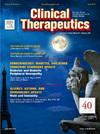Understanding Variation Among Medical Device Reporting Sources: A Study of the MAUDE Database
IF 3.2
4区 医学
Q2 PHARMACOLOGY & PHARMACY
引用次数: 0
Abstract
Background
Increasing medical device usage raises concerns regarding unexpected, potentially life-threatening events that pose public health risks. Such events are reported to the Food and Drug Administration (FDA), and cataloged in the Manufacturer and User Facility Device Experience (MAUDE) database, a vital tool for post market surveillance that requires information of high quality and integrity, particularly concerning reporting sources.
Purpose
To analyze reporting behavior among different reporters, including manufacturers, distributors, and user facilities, by examining differences in reported factors, namely: (1) device types, (2) product problem attribution, and (3) selection of Device Problem Codes (DPCs) associated with the root causes of events.
Methods
Data spanning from 2005 to 2022 was retrieved from the MAUDE database using Python. Reports were grouped by reporter type and divided according to device type, and the reporter's indication of association with a product problem. Furthermore, events were classified by their respective DPCs, which were manually grouped into four categories: device issues, user issues, clinical issues, or unknown.
Findings
The analysis revealed significant variations among reporters across all examined aspects (P < 0.00001 in all comparisons according to the proportion test). Manufacturers predominantly focused on infusion pumps (10.1%) and Implant, Endosseous, Root-Form (IER) devices (7.6%), with a product problem indication rate of 29.2% in their reports. Device issues codes were the most frequently observed category in their reports, comprising 36.3%, followed by unknown codes (32%) and clinical codes (19.3%). Distributors, on the other hand, primarily reported on IER devices (89%) and exhibited the lowest product problem indication rate at 2.7%. Clinical issues codes predominated in their reports, constituting 85.7%, followed by unknown codes (6.7%). User facilities concentrated on intravascular sets (4.7%), Electrosurgical, Cutting & Coagulation & Accessories (4.2%), and Ventricular (Assist) Bypass (4.1%). Remarkably, their product problem indication rate was the highest at 56.7%. They predominantly reported device issues codes (54.3%), followed by use codes (30.8%), and unknown codes (11.4%)
Implications
The notable variation among different reporters underscores the importance of incorporating diverse sources when analyzing the database, particularly in cases where majority of reports originate from manufacturers. Decision-makers must approach database information comprehensively, considering data sources and diverse perspectives to inform regulatory decisions effectively. Developing strategies that encourage various reporters to contribute their unique and complementary viewpoints is advisable.
了解医疗器械报告来源之间的差异:对 MAUDE 数据库的研究。
背景:医疗器械使用量的不断增加引发了人们对意外事件的关注,这些意外事件可能会危及生命,给公众健康带来风险。目的:分析包括制造商、分销商和用户机构在内的不同报告者的报告行为,研究报告因素的差异,即:(1)设备类型,(2)产品问题归因,以及(3)与事件根本原因相关的设备问题代码(DPC)的选择:使用 Python 从 MAUDE 数据库中检索 2005 年至 2022 年的数据。报告按报告人类型分组,并根据设备类型和报告人与产品问题的关联性进行划分。此外,还根据各自的 DPC 对事件进行了分类,DPC 人工分为四类:设备问题、用户问题、临床问题或未知:分析结果表明,在所有检查的方面,报告者之间都存在很大差异(根据比例检验,所有比较中的 P < 0.00001)。制造商的报告主要集中在输液泵(10.1%)和植入、骨内、根成形(IER)器械(7.6%)上,产品问题指示率为 29.2%。在他们的报告中,器械问题代码是最常见的类别,占 36.3%,其次是未知代码(32%)和临床代码(19.3%)。另一方面,分销商主要报告的是 IER 设备(89%),产品问题指示率最低,仅为 2.7%。在他们的报告中,临床问题代码占多数,占 85.7%,其次是未知代码(6.7%)。用户机构主要集中在血管内装置(4.7%)、电外科、切割和凝固及配件(4.2%)以及心室(辅助)搭桥(4.1%)。值得注意的是,他们的产品问题指示率最高,达到 56.7%。他们主要报告设备问题代码(54.3%),其次是使用代码(30.8%)和未知代码(11.4%):不同报告者之间的显著差异突出表明,在分析数据库时,特别是在大多数报告来自制造商的情况下,纳入不同来源的信息非常重要。决策者必须全面处理数据库信息,考虑数据来源和不同观点,以便有效地为监管决策提供信息。可取的做法是制定战略,鼓励不同的报告者贡献其独特而互补的观点。
本文章由计算机程序翻译,如有差异,请以英文原文为准。
求助全文
约1分钟内获得全文
求助全文
来源期刊

Clinical therapeutics
医学-药学
CiteScore
6.00
自引率
3.10%
发文量
154
审稿时长
9 weeks
期刊介绍:
Clinical Therapeutics provides peer-reviewed, rapid publication of recent developments in drug and other therapies as well as in diagnostics, pharmacoeconomics, health policy, treatment outcomes, and innovations in drug and biologics research. In addition Clinical Therapeutics features updates on specific topics collated by expert Topic Editors. Clinical Therapeutics is read by a large international audience of scientists and clinicians in a variety of research, academic, and clinical practice settings. Articles are indexed by all major biomedical abstracting databases.
 求助内容:
求助内容: 应助结果提醒方式:
应助结果提醒方式:


